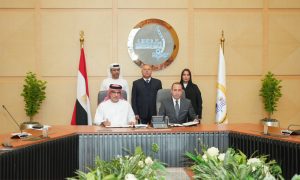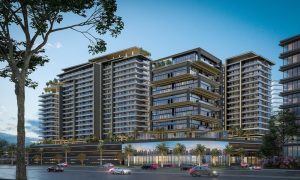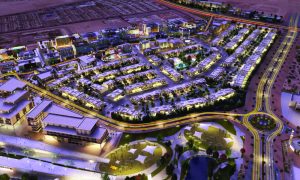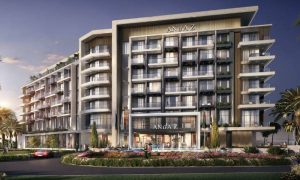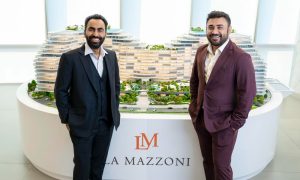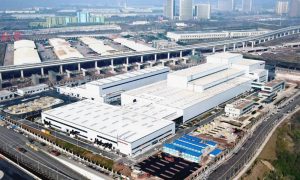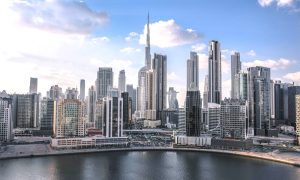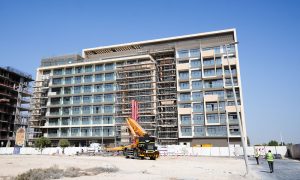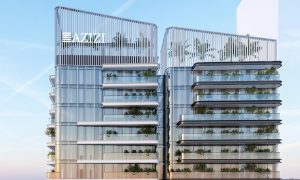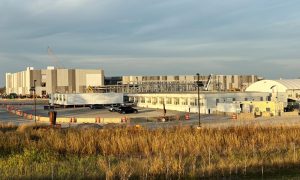Inside Dubai’s new Hyatt Regency Dubai Creek Heights hotel
A tour of the Hyatt Regency Dubai Creek Heights, which opened on March 2

In February of this year, Sheikh Mohammed bin Rashid Al Maktoum, Vice President and Prime Minister of the UAE, inaugurated the Hyatt Regency Dubai Creek Heights, completing a project that had been in development for more than half a decade.
Developed by Wasl Asset Management Group, the project consists of a five-star luxury hotel with 464 rooms and 405 luxury units in two 43-storey towers. Situated near Dubai Creek in Dubai Healthcare City, the collaboration with Hyatt, the global hospitality company, marks the entry of Wasl Asset Management into Dubai’s freehold real estate sector.
The third aspect of the project is the Hyatt Regency Dubai Creek Heights Conference Centre, which is located on the podium and is a specially designed area that can host major events on an entire floor, or individual private meetings in smaller meeting suites.
IN PICTURES: Hyatt Regency Dubai Creek Heights hotel site visit
READ MORE: Dubai ruler launches key developments, one to feature ‘snow fountain’
READ MORE: ‘Dubai needs more hotels regardless of Expo 2020,’ Hyatt exec says
READ MORE: Hyatt to launch new hotel in Dubai Healthcare City in 2015
Ahead of its March 2 opening, Big Project ME was invited to get a first-hand look at the latest addition to Dubai’s ever-growing hospitality sector. The hotel will consist of 76 suites, a Regency Club Lounge, a spa, gymnasium and fitness studios, and conference and event facilities, says Mathieu Greppo, general manager of the Hyatt Regency Dubai Creek Heights. While the city is no stranger to hotels or mega-projects, what does stand out about this project is its location, a fact that Greppo is quick to acknowledge during the tour.
“There are so many projects happening in Dubai, very often in the beach area. I think that this part of town [Dubai Creek] has been forgotten a little bit. Deira is probably the area that has been most forgotten, but now I think they’re starting to do some work there,” he points out.
“We’re somewhere in between, and this Healthcare City area is developing quite well, so there is a need for this hotel. The fact that it’s a mixed-use project, with a residential side, is going to bring huge added value to the area.” Greppo says that he expects to see 65% occupancy in the first year, and adds that he’s being conservative.
“I’m quite an optimist. Many people ask the same questions – ‘Do you believe that this city needs so many rooms?’ ‘Is this project only for Expo 2020?’ I don’t think so. [The plans for] Expo 2020 came much after. Dubai was not waiting for Expo 2020 to build their hotels. Look at the current situation of the world, there are more and more people wanting to come to Dubai. It’s a safe place. You can enjoy life and tourism is ongoing. There’s no reason why it shouldn’t continue year-on-year.”
Work on the 220,000sqm project actually began in 2006 before it was interrupted by the financial crisis that hit Dubai. It only resumed operations in 2010, with interior design work only finalised by 2011. The company tasked with bringing the project to fruition was the local contractor, Al Basti & Muktha LLC (ABM), a civil engineering and building construction firm based in Dubai. Mazhar Munshi, senior project manager for ABM, reveals that construction only restarted in May 2012, with an initial completion date of November 2013.
IN PICTURES: Hyatt Regency Dubai Creek Heights hotel site visit
“Although we were there right from the beginning, it only restarted in May 2012, and we were supposed to finish in November 2013. But because of the changes that kept happening – the design getting changed and everything –we got an extension until August 2014. Then there were still design changes happening, and so we were given until the end of the year to finish the project. We eventually got an extension of time until January 2015,” he explains.
This was clearly a fairly complicated project to pull together. While there were a number of delays and changes to plans, construction work still had to continue, creating a situation where Munshi and his team were forced to continuously be on their toes and alive to evolving requirements.
“There were a number of challenges – first of all, the volume and size of the project. That was one challenge. The other was the changes. There were design changes happening, while construction was also taking place. One of the biggest lessons we learnt was to avoid too many changes,” the project manager says somewhat ruefully. “Go as per the original design, plan things properly, allocate your resources accordingly, then do a follow-up and finish the work.”
IN PICTURES: Hyatt Regency Dubai Creek Heights hotel site visit
Given the state of flux, how did the team cope with the stress and workload of what was already a challenging project? Through cooperation and coordination, Munshi answers, explaining that planning and management of the site was a large part of the job for the project management team.
“Proper planning and arrangement and a strong follow-up helped us to get a result and to overcome the challenges. We used to have technical design workshops. For example, with the finalisation of the false ceilings, we used to have the architects, the interior design contractors and consultants, the MEP contractor, all of them in the workshops. We used to sit down all together, have a brainstorming session and agree on the way forward.
“There was an element of crisis management about the project. Basically, there’s a crisis about you finishing a particular bit of work on time, and you realise that you don’t have enough resources, so it’s just about arranging that and getting it done. The sequence of construction is affected. We had to do a lot of modifications and body work, and to do that, you have to go out of sequence. It depends on the type of work, on the volume of work that you have to do at the last moment, that’s when you do crisis management.”
IN PICTURES: Hyatt Regency Dubai Creek Heights hotel site visit
Although Hyatt weren’t involved in the early stages of the project, they did have an agreement with the owners of the project, Wasl Asset Management Group, about the standards and specifications required for the finished building. Known as Hyatt Technical Services, the agreement ensured that all the minimum specifications would be in place.
“Because engineering and design require minimum standards, we ensure that they are followed. The manuals are given to the owners, who give them to the contractors. At a later stage, we appear, with a project manager who has been hired 18 months to two years before the opening of the hotel. That person really starts to get more into the details, and he would check all of the requirements.
“That’s in terms of MEP, that the power and water treatment plants are in accordance with our requirements, all of these things are followed by the Hyatt project manager,” he clarifies.
“The general contractor, you have to remember, has no contract with Hyatt, he has a contract with the developer, so we can’t just go in and say, ‘We want this and this and this.’ While we do have some input, you also have to find the right balance between influencing the general contractor when it’s needed, while not having any contractual links. This is very crucial. You have to be very careful.”
IN PICTURES: Hyatt Regency Dubai Creek Heights hotel site visit
READ MORE: Dubai ruler launches key developments, one to feature ‘snow fountain’
READ MORE: ‘Dubai needs more hotels regardless of Expo 2020,’ Hyatt exec says
READ MORE: Hyatt to launch new hotel in Dubai Healthcare City in 2015
Usually, all standards and specifications for a hospitality project are communicated to the developer by the operator, prior to construction.
“When it comes to major things like fire and life safety, we usually get all the plans two or three years in advance and we give our standards. And then, when we’re at the final stage, we check to ensure that this has been followed,” Greppo says.
Once plans and designs were finalised, the contractor mobilised 2,500 men over the second half of 2013 and all of 2014, in an effort to get the project completed on time amidst the many challenges they faced.
The team worked on a 24-hour schedule in three shifts, pruning numbers as they approached the handover date. A small team from ABM will stay on-site for a year after the handover as part of the defect liability commitment.
“Another challenge we faced was that the laydown areas were very limited. We had to get the materials in at night, and we had to take materials to the places they were supposed to go to. That was a major challenge,” points out Munshi.
IN PICTURES: Hyatt Regency Dubai Creek Heights hotel site visit
“We weren’t allowed to make any noise pollution at night as well,” he adds.
Given that some 140,000 cubic metres of concrete was poured on-site, and around 25,000 tonnes of steel used, this was clearly not going to be easy for the team to achieve. To work their way around this, they used the four hoists attached to each tower to move materials up and down the site, the project manager says.
In addition, construction lifts were also used to move materials and the labour force about internally. During the day, things were a little easier, as each of the 43-storey towers had two tower cranes attached, which allowed the smooth transfer of building materials.
When Big Project ME visited the towers, work was almost complete on the site, with final interior work underway. Greppo explains that the final segment of the project involves his team going through the hotel and snagging any discrepancies from Hyatt’s specifications or standards.
“The beauty of this project is that the interior designers are actually doing the snagging for us. They come and snag what the contractors are doing. This is their stage – they’re in control. What they want is what is in the renderings. We then come in as an operator and we snag the ready product.
“We go more into things like the wallpaper being torn or the skirting coming off the wall. We don’t go in too deep, that’s not us.
“Our scope is that we get a turnkey agreement from our project manager, who has been on board for two years during the construction process – this will be the person who’ll hand over the building to us as the operations team. But as we come in quite early, we can assist the project manager in snagging all the areas. Once we’re happy and satisfied with the work done, then it’s officially handed over from the owner to the operator,” Greppo concludes as he brings the tour to a close.
READ MORE: Dubai ruler launches key developments, one to feature ‘snow fountain’
READ MORE: ‘Dubai needs more hotels regardless of Expo 2020,’ Hyatt exec says
READ MORE: Hyatt to launch new hotel in Dubai Healthcare City in 2015
